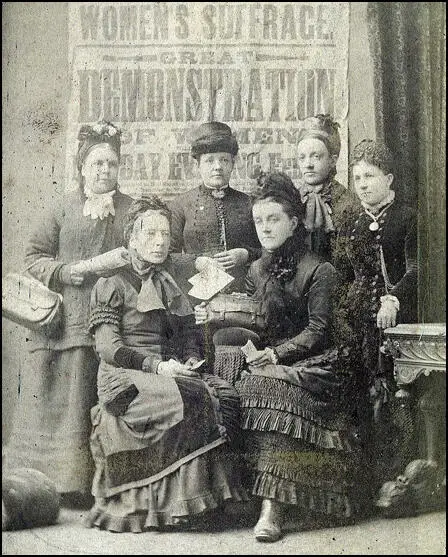Ursula Bright
Ursula Mellor, the daughter of Joseph Mellor, was born on 5th July, 1835. Little is known of her early life but it was claimed that she was "a strong generous soul, very direct, simple as a child in some ways, yet with a keen brain and fine judgment". (1)
On 13th September, 1855, Ursula married Jacob Bright, who worked for the family firm, John Bright & Brothers. Bright was deeply involved in radical politics and supported the Chartist movement. Over the next few years she gave birth to five children. Two of the boys died of diphtheria. (2)
The family moved to Manchester "where Bright developed his commercial interests, not only in cotton spinning and carpets, but also in pioneering the introduction of the linotype machine into Britain". The couple continued to be involved in radical politics and campaigned for the parliamentary franchise to both men and women. (3)
In October 1865, Elizabeth Wolstenholme-Elmy established the Manchester Committee for the Enfranchisement of Women. She gained the support of local radical members of the Liberal Party that included Ursula and Jacob Bright. Another active member included Richard Pankhurst, (4)
In November 1867, Jacob Bright was elected to represent Manchester in the House of Commons. Bright now joined forces with John Stuart Mill, another supporter of women's suffrage. In a debate on the 1867 Reform Act, Mill proposed that women should be granted the same rights as men. "We talk of political revolutions, but we do not sufficiently attend to the fact that there has taken place around us a silent domestic revolution: women and men are, for the first time in history, really each other's companions... when men and women are really companions, if women are frivolous men will be frivolous... the two sexes must rise or sink together." (5)

On 30th October 1868, the Manchester National Society for Women's Suffrage established a new executive committee that included Ursula Bright, Lydia Becker, Elizabeth Wolstenholme-Elmy, Jacob Bright and Josephine Butler. Other people who joined over the next few years included Eva Maclaren, Esther Roper and Eva Gore-Booth.
Mill lost his Commons seat in 1868, and Bright became leader of the suffragists in parliament, and took charge of the Women's Disabilities Removals Bill. In 1870 Bright and Sir Charles Wentworth Dilke introduced what was the first women's suffrage bill. After its defeat he introduced another Women's Suffrage Bill in 1871. Once again, William Gladstone, the leader of the Liberal Party, arranged for it to be defeated and commented that women voting in elections would be "a practical evil of an intolerable character". (6)
In 1870 Ursula Bright joined with Josephine Butler and Elizabeth Wolstenholme in forming the Ladies' National Association, an organisation that pressed for the repeal of the Contagious Diseases Acts. This legislation allowed policeman to arrest prostitutes in ports and army towns and bring them in to have compulsory checks for venereal disease. If the women were suffering from sexually transmitted diseases they were placed in a locked hospital until cured. It was claimed that this was the best way to protect men from infected women. Many of the women arrested were not prostitutes but they still were forced to go to the police station to undergo a humiliating medical examination. (7)
Ursula Bright was a member of the executive committee of the Married Women's Property Committee for fourteen years. The passing of the 1882 Married Women's Property Act was acknowledged to have been due to her efforts. Elizabeth Cady Stanton noted "for ten consecutive years she gave her special attention to this bill… was unwearied in her efforts, in rolling up petitions, scattering tracts, holding meetings". (8)
Under the terms of the act married women had the same rights over their property as unmarried women. This act therefore allowed a married woman to retain ownership of property which she might have received as a gift from a parent. Before the 1882 Married Women's Property Act was passed this property would have automatically have become the property of the husband. (9)
Ursula Bright was interested in the abolition of the House of Lords, opposed compulsory vaccination, and had a wide circle of friends, both artistic and political, on both sides of the Atlantic. She was also a close friend of Annie Besant and in 1898 gave £3,000 to the Theosophical headquarters in northern India. (10)
Ursula Bright died on 12th March 1915 at her home at 82 Drayton Gardens, Kensington, London.

